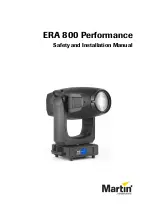
CR40/42/50 MKII Glossary of terms
Appendix A
158
PLOT function
– will require that a heading sensor (Gyro or Compass) is
connected to the CRXX. If so, then you can plot the actual cursor position on the
radar display by pressing the [PLOT] key from the radar display, and thereby
save the position in the WP-list as a waypoint i.e. you can give the plotted
waypoint a new name/number, symbol, color, etc.
PPI center
– Plan Position Indicator.
RAIN CLUTTER Control
– also known as Fast Time Constant (FTC), is used
to reduce large clutter masses caused by rain or snow and allow targets masked
by this clutter to be seen on the radar display. This control differentiates the
multitude of small radar returns from rain, effectively reducing or eliminating the
rain clutter and allowing the operator to observe larger vessel traffic within the
rain clutter. It has the effect of only displaying the leading edge of large echoes
and will tend to effect the smaller echoes only slightly. This can be of great
advantage on shorter ranges to distinguish between two very close echoes on the
same bearing which may otherwise merge and appear as one echo.
Relative Motion
Land, buoys and fixed objects move past own ship. In the
North-Up mode, you must be interfaced with an electronic compass for proper
operation.
SEA CLUTTER Control
– also known as the Sensitivity Time Control (STC),
is normally used on the shorter ranges to suppress the effects of sea clutter close
to own ship by reducing the nearby gain level. It can effectively reduce the
strength of the mass of random echoes received from nearby sea clutter for up to
approx. 3 to 5 nm depending on wave and sea conditions. STC control is set to
reduce the strength of these echoes such that the clutter appears only as
intermittent small dots, yet small targets can still be distinguished.
)
On short range scales, the setting of the sea clutter control should never be
advanced so high as to obliterate all clutter, since this setting could prevent the
detection of close in-target echoes.
Trails
– is a feature which allows the operator to see the past history of target
movement as an after-glow or “Wake” behind the moving targets or own ship.
If the range scale is changed, the trails are cleared and new trails histories will be
redrawn to the screen.
The trails are drawn for anything that moves on the screen, including sea gulls,
sea clutter, buoys, lobster pots, and shoreline. In general it is better to use the
Содержание CR40 MKII
Страница 50: ...CR40 42 50 MKII Position menus Chapter 4 50...
Страница 120: ...CR40 42 50 MKII Installation and service Chapter 9 120 Other important settings continued...
Страница 160: ...CR40 42 50 MKII Glossary of terms Appendix A 160...
Страница 174: ...CR40 42 50 MKII DGPS ChartRadar Index 174...
















































